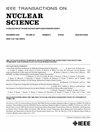瑞士fel c波段直线加速器中真空击穿和射频调理的多年纵向分析
IF 1.9
3区 工程技术
Q3 ENGINEERING, ELECTRICAL & ELECTRONIC
引用次数: 0
摘要
SwissFEL是一种x射线自由电子激光器(XFEL),自2017年12月以来一直处于常规用户操作中。gev规模的电子束由一个420米长的线性加速器(linac)驱动,该加速器由27个射频模块组成。每个射频模块有四个c波段加速结构,其平均加速梯度为30 MV/m。这些加速结构是通过采用超高精密加工和钎焊进行批量生产实现的,生产成品率超过99%。在将每个加速结构安装到各自的RF模块中后,开始进行大功率调理,需要3到6亿个RF脉冲才能达到每个RF模块240 MV的标称加速电压。在用户操作期间,射频模块内部的击穿率开始下降,这是由于标称高功率操作附带的射频调节的结果。击穿率的降低遵循幂律趋势,在用户操作的前三年,击穿率降低了三个数量级以上,从每脉冲每米击穿10^{-6}美元降至10^{-9}美元以下。对故障位置的后处理分析发现,它们聚集在输入射频耦合器和加速结构的中央规则单元周围。考虑到该分析由100个加速结构组成,每个加速结构都具有相同的RF设计和制造方法,该分析代表了单一加速结构设计中产生的最大的RF调理和真空故障数据集之一。本文章由计算机程序翻译,如有差异,请以英文原文为准。
Multiyear Longitudinal Analysis of Vacuum Breakdown and RF Conditioning in the C-Band Linac of SwissFEL
SwissFEL is an X-ray free-electron laser (XFEL) that has been in regular user operation since December 2017. The GeV-scale electron beam is driven by a 420-m-long linear accelerator (linac) consisting of 27 radio frequency (RF) modules. Each RF module has four C-band accelerating structures that operate at an average accelerating gradient of 30 MV/m. These accelerating structures were realized through a series production using ultrahigh-precision machining and brazing that saw the structures fabricated on-tune with a production yield rate of over 99%. After installing each of the accelerating structures into its respective RF module, the high-power conditioning began, taking between 300 and 600 million RF pulses to achieve the nominal accelerating voltage of 240 MV per RF module. During the user operation, the breakdown rate inside the RF modules began to fall as a result of RF conditioning incidental to the nominal high-power operation. This reduction in breakdown rate followed a power-law trend that saw it reducing by over three orders of magnitude during the first three years of user operation, from $10^{-6}$ to less than $10^{-9}$ breakdown per pulse per meter. A postprocessing analysis of the breakdowns’ locations found that they cluster around the input RF coupler and central regular cells of the accelerating structures. Given that this analysis consists of 100 accelerating structures, each with the same RF design and method of fabrication, this analysis represents one of the largest datasets of RF conditioning and vacuum breakdowns ever produced for a single accelerating structure design.
求助全文
通过发布文献求助,成功后即可免费获取论文全文。
去求助
来源期刊

IEEE Transactions on Nuclear Science
工程技术-工程:电子与电气
CiteScore
3.70
自引率
27.80%
发文量
314
审稿时长
6.2 months
期刊介绍:
The IEEE Transactions on Nuclear Science is a publication of the IEEE Nuclear and Plasma Sciences Society. It is viewed as the primary source of technical information in many of the areas it covers. As judged by JCR impact factor, TNS consistently ranks in the top five journals in the category of Nuclear Science & Technology. It has one of the higher immediacy indices, indicating that the information it publishes is viewed as timely, and has a relatively long citation half-life, indicating that the published information also is viewed as valuable for a number of years.
The IEEE Transactions on Nuclear Science is published bimonthly. Its scope includes all aspects of the theory and application of nuclear science and engineering. It focuses on instrumentation for the detection and measurement of ionizing radiation; particle accelerators and their controls; nuclear medicine and its application; effects of radiation on materials, components, and systems; reactor instrumentation and controls; and measurement of radiation in space.
 求助内容:
求助内容: 应助结果提醒方式:
应助结果提醒方式:


